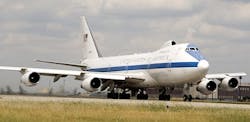SPECIAL REPORT, 7 Feb. 2011.Overall control of the U.S. arsenal of land-based intercontinental ballistic missiles (ICBMs), its submarine-launched ballistic missiles, as well as its nuclear-capable bomber aircraft, comes from the Nuclear Command and Control System (NCCS), which describes an infrastructure of fixed-site locations, aircraft, and land vehicles -- all with strategic radiation-hardened communications capability.
For more on ballistic missile guidance and battle management, see related story entitled Nuclear ballistic missile command and control technology still a prime military concern.
Only the president of the United States has final authority to authorize use of strategic nuclear weapons like the ICBMs and submarine-launched ballistic missiles. The NCCS, however, helps the president communicate with his top military commanders to direct nuclear forces. The architecture of the NCCS takes into account the possibility of enemy strikes that disable or destroy some of its installations and platforms, and plans for handing off authority and tasking in case of enemy attack.
Primary parts of the Nuclear Command and Control System are the National Military Command Center (NMCC), the U.S. Strategic Command Global Operations Center, and so-called Site-R. Mobile components of the NCCS include the E-4B National Airborne Operations Center, the E-6B Airborne Command Post, and the Mobile Consolidated Command Center.
Today's Nuclear Command and Control System emphasizes strategic communications, intelligence, and planning, as well as the traditional triad of nuclear forces consisting of land-based ICBMs, submarine-launched missiles, and strategic bomber aircraft.
The National Military Command Center -- perhaps the single most important command-and-control node of the nation's nuclear forces -- is the primary day-to-day location for nuclear command and control. It is staffed around the clock, and is located in a shielded room in the Pentagon just outside of Washington. This site is responsible for monitoring nuclear forces and national military operations.
The U.S. Strategic Command Global Operations Center serves as a backup for the National Military Command Center in case of the latter's destruction or damage. It is located underneath U.S. Strategic Command headquarters at Offutt Air Force Base outside Omaha, Neb. The center is protected against electro-magnetic-pulse (EMP), and has its own emergency power supply. It is staffed round the clock.
Site-R is a standby strategic command post at Fort Ritchie, Md., outside of Washington, and can be brought online quickly if necessary.
Several specialized and radiation-hardened aircraft also take part in the Nuclear Command and Control System. Chief among these is the National Airborne Operations Center, represented by a fleet of modified Boeing 747-200B jumbo jets functioning as survivable mobile command posts called the Boeing E-4B Advanced Airborne Command Post.
The E-4B is the aircraft that in case of nuclear war would be the airborne command post for the president of the United States, the secretary of defense, and other high government officials. These aircraft are based at Offutt Air Force Base, Neb.
The E-6B Airborne Command Post is a modified Boeing 707 jetliner serves as a backup to the U.S. Strategic Command Global Operations Center should the ground-based site be unable to fulfill its mission. The E-6B Airborne Command Post has a crew of 22, including pilots, communications operators, and battle staff personnel.
The E-6B is designed to be a versatile command-and control aircraft in times of nuclear confrontation. Acting as the Airborne Command Post it can serve as the Airborne Launch Control System with its ability to communicate launch codes directly to land-based ICBM sites. The E-6B aircraft could command ICBM launch if the launch control centers are unable to perform their missions.
The E-6B, in addition to its ability to communicate with land-based ICBM sites, also can communicate with deployed U.S. Navy ballistic missile submarines in the aircraft's additional role as the Take Charge and Move Out (TACAMO) communications relay. As the TACAMO aircraft, the E-6B can deploy a 2.5-mile trailing wire antenna to give orders to submerged submarines over the vessels' very-low-frequency/low-frequency (VLF/LF) communications systems, which can receive information through the water at very slow data rates.
The E-6B aircraft also can communicate over UHF and EHF military satellite links. The E-6B fleet is based at Tinker Air Force Base, Oklahoma.
The final node in the Nuclear Command and Control System is the Mobile Consolidated Command Center, which is a convoy of trucks that can deploy in a nuclear crisis as a road-mobile backup to the Global Operations Center or Airborne Command Post if circumstances warrant a mobile land-based strategic command post.

